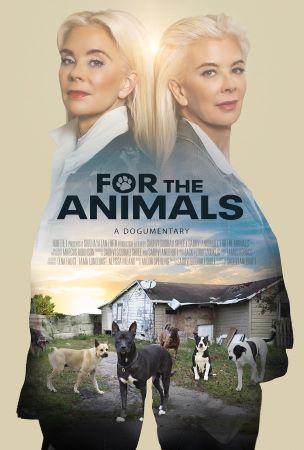
For the Animals 2022
Distributed by Collective Eye Films, 1315 SE 20th Ave. #3, Portland OR 97214; 971-236-2056
Produced by Sadhvi Anubhuti and Sadhvi Siddhali Shree
Directed by Sadhvi Anubhuti and Sadhvi Siddhali Shree
Streaming, 66 mins
General Adult
Activism; Animal Welfare
Date Entered: 11/10/2023
Reviewed by Morgan Bond, Electronic Resources & Systems Librarian, SUNY OswegoFor The Animals is simultaneously an inspirational and heartbreaking view into the animal welfare crisis in Houston, Texas, which is representative of a larger problem in the United States. The film follows twin sisters, Tena Lundquist Faust and Tama Lundquist in their efforts to lead rescue efforts and coordinate with other local individuals and rescue groups to spread awareness of the stray dog crisis in Houston and bring low cost or free services to the community. The filmmakers follow the sisters and local feeders in several rescue attempts, exposing viewers to scenes of impoverished areas and dogs in dire situations. Multiple scenes and descriptions of neglect and abuse are disturbing but give viewers a small glimpse of the constant struggles and emotional circumstances animal rescuers and feeders are exposed to.
The film reveals the multitude of factors contributing to the increasing stray dog population in Houston: lack of information about pet welfare and medical services, access to spay and neuter clinics, social stigma, cultural differences, and in some extreme cases, a lack of compassion for animals. Interviews with local rescuers draw connections between animal suffering and human suffering, acknowledging that one cannot be solved without addressing the other. The film also does an admirable job drawing connections between decisions made by elected officials, policy shortcomings, community outreach efforts and the importance of working at all levels to address such a complicated issue. For The Animals highlights the challenges rescue groups are faced with: a severe shortage of homes to adopt stray pets, overcrowding of shelters, and the unfortunate reality of euthanasia. The emotional and physical strain on the rescuers is apparent in several scenes, and at times the film makes the issue seem insurmountable as rescuers describe growing numbers of homeless pets despite their efforts, pushback from the community, and emotionally charged stories of personal sacrifice.
The film offsets the distressing scenes of animal suffering with moments of hope, providing vignettes demonstrating the powerful influence individuals can have; stressing that positive action can have an impact even on a small scale, even if it only saves one animal. The film ends on an encouraging and optimistic note, highlighting the successes of Houston rescue groups and setting an example of what can be accomplished in the future with cooperation, funding, and support from elected officials.
Although I recommend this film for adult audiences interested in animal welfare, animal rights, and activism, viewer discretion is strongly advised. As mentioned previously, there are multiple images and vivid descriptions of animal abuse, neglect, and euthanasia that may be disturbing to some viewers, and are borderline excessive.
Published and licensed under the Creative Commons Attribution 4.0 license. Anyone can use these reviews, so long as they comply with the terms of the license.